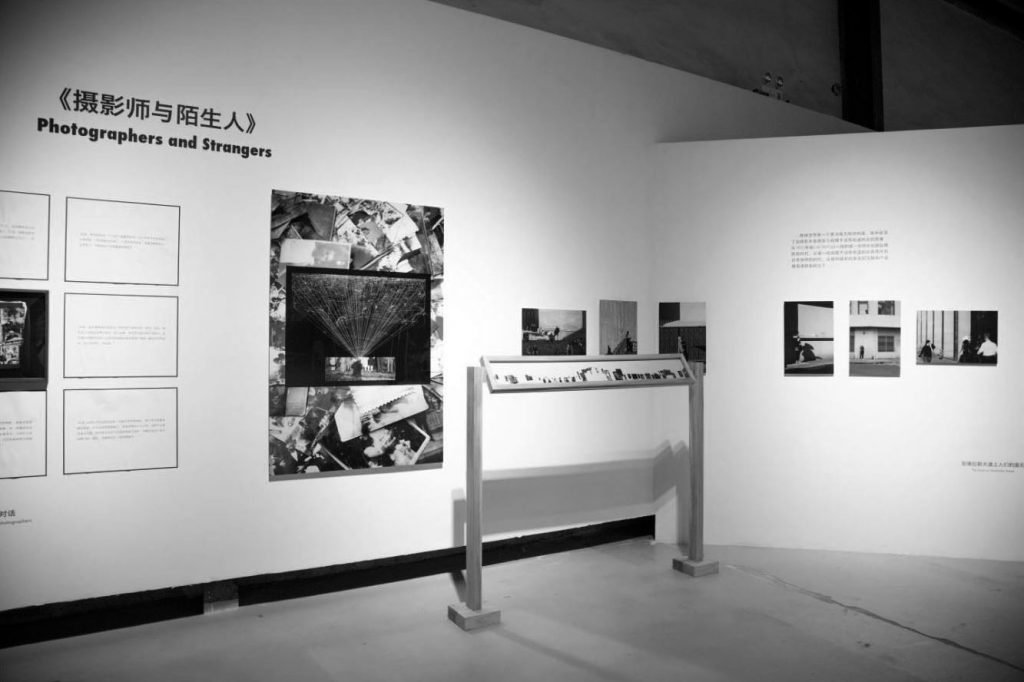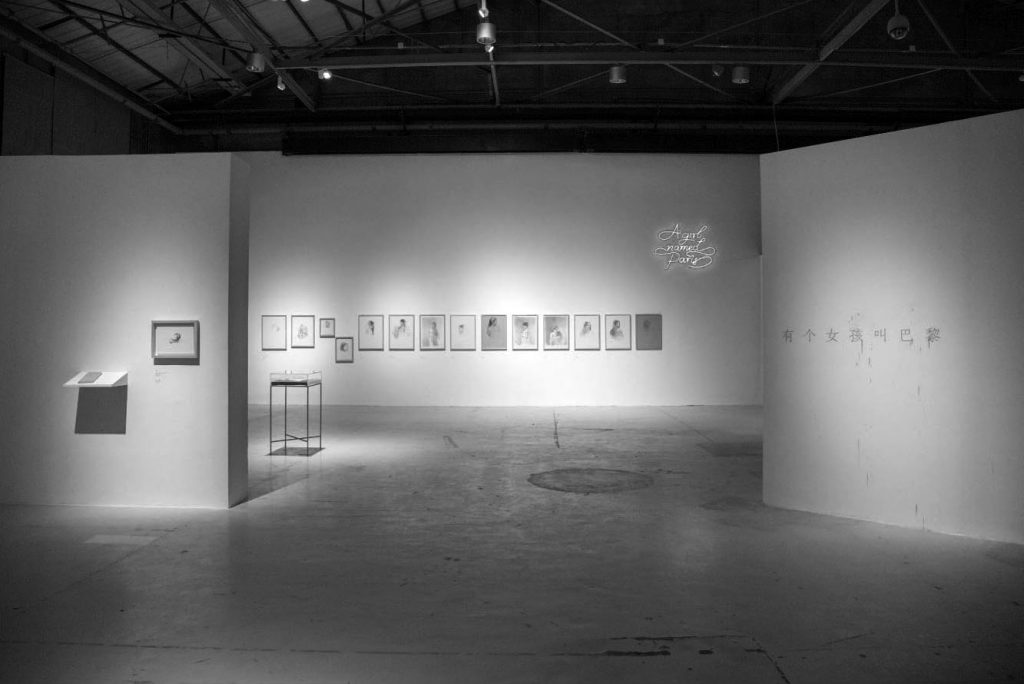From Writing to Presentation:
On Artist Fiction
Fiction Art
OCAT Shenzhen, Shenzhen
23.06.18 – 12.08.18
Translated by Bridget Noetzel
In recent years, various types of artists’ writing have been incorporated into the contemporary art system. If this kind of writing most often serves to reveal the inner structures of a work of art, then we may be inclined to regard it as more of an autonomous category, which goes beyond the role of organising, explaining, examining and defending artistic creation.
The exhibition Fiction Art takes a sampling of artists’ fictional writing and brings them from the digital and physical publication platforms back into the curatorial context. This experiment provides a context for discussing questions that urgently demand our attention: How should we define artists’ fiction? What creative need does it meet? Does it more effectively constitute an artistic medium that synchronically forms a whole with other creative forms?
In Duan Jianyu’s New York, Paris, Zhumadian ( 2008 ), Wang Kefu: The Story of an Art Lover ( 2008 ) and new work Secret Garden ( 2018 ), poor university students, art lovers, and rebels resurfacing from the underground, are restored to reality via important individual and public events. This strategy of using fictional narratives as metaphors for reality is also seen in the works of several of the other artists. Chen Dong has fashioned a middle-aged couple driving along a highway in video and text messages. Feng Feng has fabricated a daughter, who could not have been born, on account of the One Child Policy, from a pre-existent collection of writing and images. Jiang Zhi’s allegories and installations use the Chinese character for ‘mouth’, a square, to tell a tale about the pressures of censorship. Qin Jin’s wall paintings and Kafkaesque fiction are about a wife in a repressive household, who changes into a butterfly.
These artists born in the 1970s inject an intellectual’s humanist concerns into their texts, like an afterglow from the ’85 New Wave Movement. In contrast, their writing departs from long-standing models for artists’ texts, such as Joseph Kosuth’s philosophical considerations, or the Chinese literati’s emphasis on the intrinsic connection between text, calligraphy and painting. After the ideals of avant-garde art had been dispelled, artists’ strategies shifted from the conceptual and abstract to an explanation of specific issues, and larger narratives gradually gave way to individual experiences in times of social change. Consequently, artists have taken up the tools of the novelist and introduced references to social reality into their texts, thereby fighting for space to experiment with materials.
Likewise, Duan Jianyu’s paintings attacking aesthetic formulas, Jiang Zhi’s wordless book, Feng Feng’s archive of ready-mades, and Chen Dong’s video of a performance, respectively, have smoothly shifted the focus of their enquiries, to the extent of questioning the limits to their powers of expression. Fictional narratives provide their creators with a compromise between the idea that art reflects reality and their desire to explore the characteristics of a particular medium.
The fictions created by these artists are usually structurally sound and independent of the visual dimension. In contrast, the younger artists tend to attenuate the divisions between the fiction and the other media employed, strategically keeping their writing closer to literature, in a general sense. As a result, they dispense with the monotonous logic of rooting visual art in a text, or transforming text into image.
For artists early in their careers, the authority of critical discourse has already been lost, and various types of artistic text have become more pervasive. The temporary lack of an outside explanation sparks ‘interpretive anxiety’.1 Thus, they often organise and defend their practices with theoretical writing, and artists’ fiction becomes a more political use of text, built upon this foundation.

Yang Yuanyuan, Where the Sightlines Cross, 2016. Installation view, Fiction Art, OCAT Shenzhen, 2018. 杨圆圆,《在视线交错之处》( “小说艺术”展览现场 ),2018 年
Shi Zhenhao has written the ‘Visual Research Society’ column in FONGFO under three different pen names; Pu Yingwei has entered a historical site as another kind of character; while Yang Yuanyuan’s Where the Sightlines Cross ( 2016 ) narrates the experiences of several photographers in Porto Alegre, Brazil, and enters the story as the last character in a semi-fictional photographic history of this city. These artists’ working methods reflect contemporary art’s appropriation of field research and other methods from sociology. Artists use fiction instead of field logs to link together real material and artistic recreations, while also blurring the boundaries between research and fiction.
More importantly, writing is a dimension that can provide material support to the individual. These artists may also be considered writers, commentators and editors ( even if they seldom call themselves novelists ). Fiction serves to demarcate the boundaries of their own identities, and they become the subjects of their writing. In their fictions, they shape further identities, or set out on nomadic journeys. They seek out their own place in the morass of the cultural system. With their status as authors, they intervene in the production and dissemination of artistic discourse. In the fictions of the middle-aged artists, there are still existential, subject – object relationships between the author and the subject, but these become more blurred with the younger generation.
These age-based observations do not mean that the logic of artists’ fiction evolves over time. On the basis of a small number of samples, we have tried to suggest that artists’ use of different kinds of fiction may be broadly divided into two different tendencies, determined by the methods they use and their underlying creative motivation. In retrospect, we can see that there is nothing new about artists’ fiction, and that the artist’s way of linking their writings to other forms of creation from the publishing world has simply added to the tools at their disposal. The issues raised by this exhibition are certainly very timely, as the show also questions how to mediate the relationship between the book and the work of visual art, at the moment of presenting this to a public.
Speaking of writing a book, Duan Jianyu believes that she is simply ‘borrowing’2 from the writer’s domain, which means that artist’s exploration of different media is always embodied in visual creation, not text. There seems to be a general disequilibrium in the way that the languages of literature and art have developed, and this reflects a consensus among artists about the way that books should be made: the subject of their work has always been contemporary art, and does not form part of a linguistic or literary tradition. This does not suggest an absolute equivalence of media ( Jiang Zhi, for example, has published several purely literary novels, and directly exhibited her texts, as works of art ), but it is a precondition for incorporating contemporary art into the discussion of fiction. In addition, we cannot deny that the impact of a text on the viewer always lags behind that of a work of visual art. This reflects the special place that artists’ fiction has in presentational logic and time, but it also places harsh demands on the overall presentation of the work.
In this exhibition, the artists’ works of fiction were independently printed and made into books. In their fabrication, these small books are markedly different from literary publications, but due to the somewhat arbitrary nature of their layout, they do not have the richness of expression of artists’ books. ( Yang Yuanyuan’s independently written book is a special case here. ) In fact, some of these books are actually the compilation of several fictions, so the text is not truly redundant. This means that the books and the visual works show a set but disjointed relationship to one another, though this does make it easier for the books to be related to a novel form of subtext. This arrangement reveals a certain unease about managing the relationship between the books and the visual works in the exhibition, and it also makes the curator’s description of the exhibition – as ‘opposed to spectacles and rapid consumption’ – sound more like a piece of defensive rhetoric.
In the end, the key issue is that artists’ fiction is always a creative form that is not entirely physical. When these fictions create numerous link-ups with contemporary art, they play an indeterminate role between artwork, commentary and documentation, but they also present an ambiguous attitude that rejects convention, but often declares its rationality. This charming quality makes us hesitate about how we choose to present artists’ writing, and even critique it. Of course, it quickly has measurable value, in the name of the production of knowledge, or art, but does this mean that, by confirming the creator as an artist, we can determine the legitimacy of the text as an artistic presence, and endorse the absolute validity of all means of including it in an exhibition? What we can say for sure is that we fall short in our appreciation of artists’ fiction if we have no interest in discussing the above question and simply try to revalidate it, by treating textual art as an artistic byproduct, or an exquisite game.
1. Liu Xinyi, ‘Work at the Art Writing Workshop’, Salt Projects WeChat Account, 27 April 2016. Liu Xinyi believes that his own writing stems from ‘an interpretive anxiety’, because ‘when we cannot look to an expert, we urgently need a text to describe our own practices’.
2. ‘In Conversation with Duan Jianyu: Text is Like a Crutch’, OCAT Shenzhen WeChat Account, 22 July 2018.
从书写到展示——谈“艺术家小说”
小说艺术
OCAT 深圳馆,深圳
2018 年6 月23 日—2018 年8 月12 日
近年来,各类型的艺术家写作已被普遍纳入当代艺术系统。如果说这一文字大类多被赋予揭示创作内在肌理的功能,那么“艺术家小说”则是其中一种更具自主性的类别——它并不满足于对创作的梳理、阐释、反省和辩护。
展览“小说艺术”对艺术家的虚构写作进行采样,使其从数字和实体出版物平台回归到策展话语中。这一尝试为如下亟待厘清的问题提供了讨论语境: 我们应如何定义“艺术家小说”,它承载了何种创作需要,又在多大程度上能够有效地构成一种艺术媒介,与其他创作形式共时地构成作品的整体?
在段建宇的《纽约巴黎驻马店》( 2008 )、《王克服,一个美术爱好者的故事》( 2008 ) 及新作《秘密的花园》( 2018 ) 中, 贫困大学生、美术爱好者和从地底钻出的造反者等角色均脱胎于现实中代表性的个体和公共事件。这种以虚构叙事隐喻现实的策略也同见于部分艺术家的作品: 陈侗的录像和短信塑造了一对奔波于国道上的中年夫妻; 冯峰长期的书写和图像收藏虚构出一个因计划生育政策未能出生的女孩; 蒋志的寓言和装置借一个只能以空格形态得到发表的字之口,道出审查制度的压迫; 秦晋的壁画和卡夫卡式的小说则有关于一个在压抑家庭中化蝶的妻子。
上述生于20 世纪70 年代前后的艺术家们在文字中注入了知 识分子式的人文关怀,这几乎像是“85 新潮”的余温。不同的是, 他们的写作脱离了长久以来艺术家文本的范例——约瑟夫·科苏斯式的哲学性思考,或中国文人画对文本、书法和图画内在联系的强调——前卫艺术的理想退潮后,艺术的策略从观念和抽象转为对具体问题的阐释,而宏大叙事也逐渐让步于社会转型时的个体经验。于是,艺术家拾起了小说工具,并将对社会现实的指涉转接到文本上,从而为媒材实验争取空间。

Duan Jianyu, Secret Garden, 2018. Installation view, Fiction Art, OCAT Shenzhen, 2018. 段建宇《秘密的花园》( “小说艺术”展览现场 ),2018 年
相应地,段建宇挑衅着审美定式的绘画、蒋志的“无字书”、冯峰的现成物档案库和陈侗的表演录像自如地向自身的表达阈限发起了质询。在“艺术反映现实”论与媒介语言的探索之间,虚构叙事为创作者提供了折衷策略。
如上艺术家的小说通常结构完整,且独立于视觉作品; 相较之下,更年轻一代的创作者则倾向于弱化小说与其他媒介语言之间的分野,又策略性地使他们的写作与一般意义上的文学保持着距离,从而消解了将视觉创作建立于文本之上,或反之,将文本内容转化为图像的单一逻辑。
对于职业初期的艺术家来说,在批评话语的权威已然失落, 而各种类型的艺术文本更加泛滥的今天,外部阐释的暂时缺失激发了他们的“解释焦虑”1。因此,他们往往通过理论性的写作来梳理并捍卫自身的实践,而“艺术家小说”则是在此基础之上, 对文字更为政治性地运用。

Feng Feng, A Daughter Called Paris, 2017 – 18. Installation view, Fiction Art, OCAT Shenzhen, 2018. 冯峰《有个女孩叫巴黎》( “小说艺术”展览现场 ),2017—2018 年。
史镇豪以三个不同的笔名撰写《冯火月刊》的专栏“视研社”; 蒲英玮在小说中以另一重人格进入历史现场; 杨圆圆则在《在视线交错之处》( 2016 ) 中讲述了巴西阿雷格里港数名摄影师的经历,并作为最后一名人物走入故事,半虚构了该城的摄影史。他们的工作方法反映出当代艺术对田野调查等社会学科研究方法的借鉴: 艺术家以小说代替调查日志,串联起真实的素材和艺术的再创造,同时模糊了研究和虚构间的界限。
更重要的是,写作也支撑起了创作者个体存在的一个维度。除艺术家外,他们在现实中也可以是撰稿人、评论者和编辑( 即便他们极少称自己为小说家 )——小说充当着他们个人身份边界的探测器,而他们也成了自己书写的对象。他们在小说里塑造分身,或踏上游牧的旅程,在文化系统盘根错节的时代寻找自己的位置; 或借作者的身份,介入艺术话语的制造和传播。在中生代艺术家的小说中仍存在的、作者与书写对象间的主客体关系,对更年轻一代而言已变得十分模糊。
如上以年代为线索的观察并不代表“艺术家小说”有着某种随时间演进的发展逻辑,而仅仅是在少数样本的基础上,尝试对“艺术家小说”在创作动机和方法上的两种大致倾向进行分析。溯其历史,“艺术家小说”并非新潮之物。然而,随着出版及创作项目衍生出了更多的组织形式,“艺术家小说”正通过联动写作计划等方式形成现象级的趋势。因此,展览在此刻将其提上讨论日程无疑是适时的; 同时,它也对如何在呈现环节上协调小说和视觉创作间的关系做出了提问。
谈到写小说,段建宇认为自己不过将作家的领地“借着用一用”2,意即艺术家对媒介语言的探索总是体现在视觉创作而非文字上。这种文学与艺术语言的不平衡发展是具有普适性的,它反映出艺术家在小说创作上的共识: 其作业对象始终是当代艺术, 而不是语言或文学传统。尽管这并不构成一种绝对的媒介等级观念( 例如蒋志曾发表过数篇纯粹文学意义上的小说,并直接将文本作为作品展出 ),它却是当代艺术能够将小说纳入讨论范围的前提。此外,不可否认的是,文本对观者的影响和冲击总是滞后于视觉创作。这均体现了“艺术家小说”在展示逻辑和时间性上的特殊之处,也对作品的整体呈现提出了更加苛刻的要求。
此次展览中,“艺术家小说”被独立印刷成册; 这些小册子在形制上与文学出版物有着明显区别,却又由于排版逻辑的单薄而在表达的丰富性上不及艺术家书( 杨圆圆独立编排的书是其中的特例 )。其中部分书册实则是数篇小说的集合,而文本“冗余” 的部分并不曾真正地“在场”。这使小说与视觉作品间形成了“配套”而“脱节”的关系,也令其更易于被简化为一种新颖形式的副文本。此种安排暴露了展览在调配小说和视觉作品间关系时的不适,也使策展人对展览“反景观、反快速消费”的描述更像是一种辩护式的修辞。
最终,问题的关键在于“艺术家小说”就本质而言应是一种不宜被完全“实体化”的创作形式。当它游走于当代艺术的多个环节,扮演着介于“作品”“评述”和“文献”之间的不定角色时,也展现出拒绝被常规化、却不时宣告着自身合理性的暧昧姿态——这一迷人特质使我们对于应如何呈现艺术家的写作,乃至是否要将其纳入批评的范围始终抱着犹疑的态度。当然,它能够迅速地被冠以知识或艺术生产之名,输出可量化的价值,但这是 否意味着仅通过确认其创作者为艺术家,我们就能不加区别地赋予文字作为艺术本体存在的合法性,并宣告包括展览在内的所有呈现方式是绝对有效的? 可以肯定的是,若我们无意对如上问题进行商榷,并对“艺术家小说”在诸多层面上生效的情境进行还原, 也就等同于将文字创作放在了艺术副产品的位置上、视其为一种精致的游戏。这亦是对“艺术家小说”的辜负。